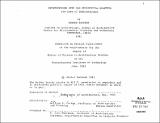| dc.contributor.advisor | William L. Porter. | en_US |
| dc.contributor.author | Badshah, Akhtar | en_US |
| dc.contributor.other | Massachusetts Institute of Technology. Dept. of Architecture. | en_US |
| dc.coverage.spatial | a-ii--- | en_US |
| dc.date.accessioned | 2011-06-20T15:40:52Z | |
| dc.date.available | 2011-06-20T15:40:52Z | |
| dc.date.copyright | 1983 | en_US |
| dc.date.issued | 1983 | en_US |
| dc.identifier.uri | http://hdl.handle.net/1721.1/64499 | |
| dc.description | Thesis (M.S.)--Massachusetts Institute of Technology, Dept. of Architecture, 1983. | en_US |
| dc.description | MICROFICHE COPY AVAILABLE IN ARCHIVES AND ROTCH | en_US |
| dc.description | Bibliography: p. 93-96. | en_US |
| dc.description.abstract | The thesis develops design guidelines for interventions into residential quarters of the old core cities in the Third World. Their purpose is to provide a suitable framework for developing residential designs maintaining the characteristics of the traditional environment without restricting the aesthetic commitments of the designer. A clearly defined area within Shahjahanabad, the walled city of Delhi, was studied, identifying change currently taking place in their physical, social and economic aspects. three cases are described to illustrate the various components of the walled city as a whole. Two are traditional areas; the third is a new development to which they are compared. On the basis of these studies, which identified the formal elements both within the urban fabric and within some typical houses, the set of design guidelines was then developed. the prototypical design then tests out some of those guidelines. the thesis concludes that when intervening in a traditional environment, the designs must incorporate the functional demands of a changing society, adapt to the occupants' needs, and react to social pressures, if social, economic, and functional obsolescence is to be avoided. The guidelines developed are designed for use both by practitioners seeking to improve the traditional environment and by planners and government agencies contemplating intervention in traditional quarters of old cities. | en_US |
| dc.description.statementofresponsibility | by Akhtar Badshah. | en_US |
| dc.format.extent | 97 [i.e. 95] p. | en_US |
| dc.language.iso | eng | en_US |
| dc.publisher | Massachusetts Institute of Technology | en_US |
| dc.rights | M.I.T. theses are protected by
copyright. They may be viewed from this source for any purpose, but
reproduction or distribution in any format is prohibited without written
permission. See provided URL for inquiries about permission. | en_US |
| dc.rights.uri | http://dspace.mit.edu/handle/1721.1/7582 | en_US |
| dc.subject | Architecture. | en_US |
| dc.title | Interventions into old residential quarters : the case of Shahjahanabad | en_US |
| dc.type | Thesis | en_US |
| dc.description.degree | M.S. | en_US |
| dc.contributor.department | Massachusetts Institute of Technology. Department of Architecture | |
| dc.identifier.oclc | 11474569 | en_US |
